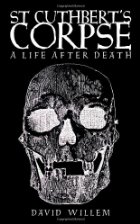 St. Cuthbert died over 1300 years ago, but the mystery of his incorrupt corpse has continued to fascinate generations of religious Brits, especially Northerners. Years after St Cuthbert died, a group of monks opened his tomb for the first time and were amazed to discover that he appeared lifelike in every way; though his body was covered with a white shroud, his limbs were flexible and his skin pliable. Over the centuries, his tomb has been moved across northeast England, finally finding a home in Durham Cathedral, but it’s been opened five times since with different discoveries made each time. David Willem looks at the original sources of each tomb opening to create the most reliable possible account of the corpse’s history.
St. Cuthbert died over 1300 years ago, but the mystery of his incorrupt corpse has continued to fascinate generations of religious Brits, especially Northerners. Years after St Cuthbert died, a group of monks opened his tomb for the first time and were amazed to discover that he appeared lifelike in every way; though his body was covered with a white shroud, his limbs were flexible and his skin pliable. Over the centuries, his tomb has been moved across northeast England, finally finding a home in Durham Cathedral, but it’s been opened five times since with different discoveries made each time. David Willem looks at the original sources of each tomb opening to create the most reliable possible account of the corpse’s history.
I found this book unexpectedly fascinating, so much so that I actually came home from reading it on my commute and told my husband all about it (he’s not a history person but tends to listen patiently to my excited ramblings, as in this case). It’s a short book which I read over just two days, covering each instance of tomb-opening from the saint’s death to the last opening in 1899. There is no real ending possible, although the author does draw some conclusions; the saint’s corpse is still in the awe-inspiring Durham Cathedral, but it’s quite unlikely that it will be opened again any time soon. But the way he traces back the history and tries to figure out exactly what happened and how a corpse could be “incorrupt” two hundred years after burial was really interesting. It’s also fascinating to see what might happen to a prominent person’s body for centuries after death. This saint hasn’t been forgotten in the slightest and it does serve to remind us of how our mortal remains might gain a history of their own.
This is a very tightly focused book and doesn’t include much context; we don’t really learn much about what’s happening outside the small piece of the world inhabited by the corpse and those who tended to it. But for someone with a good background of the various periods of history, it’s clear that the corpse is actually impacted by each, from the Viking and Norman invasions to the dissolution of the monasteries right up to the later Victorian interest in antiquities. The way the corpse is treated is itself indicative of the general atmosphere at each given point. Very designed for people who already love history, rather than those who might be dipping their toe into the water, the book contains a number of excerpts from the primary sources consulted by the author. He’ll normally tell the story (and let it be told through the eyes of the primary sources) and then look more carefully at what the person has actually said.
In summary, I really enjoyed St. Cuthbert’s Corpse and would happily read more like it. A quick read that nevertheless adds a dimension onto history, certainly worth the time I spent reading it. I now know a lot more about St. Cuthbert and I’d like to go back to Durham Cathedral to visit the tomb in person.
I received this book for free for review.









Recent Comments